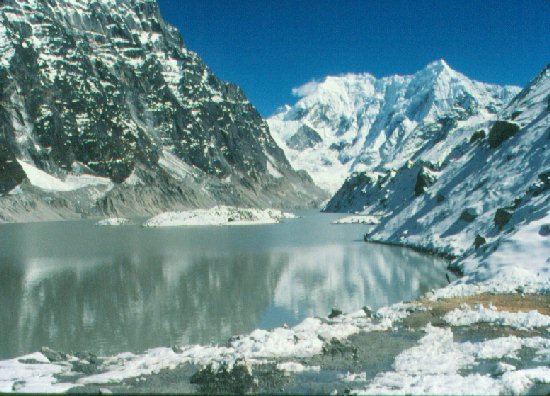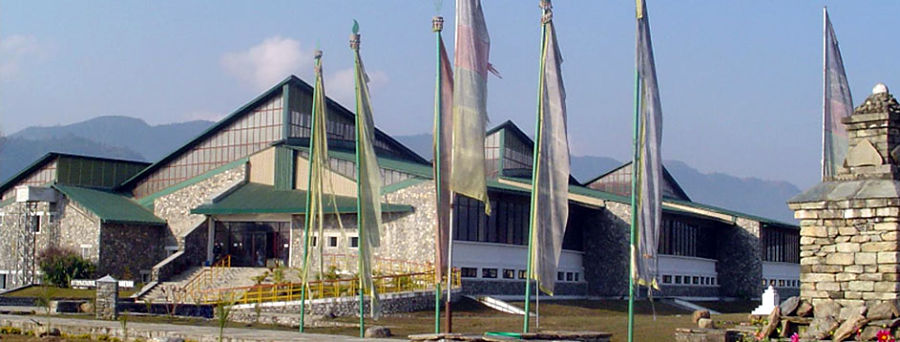

The Disaster Management University proposal is a project of Mountain Legacy International, Inc., a non-profit agency incorporated in New York State. Our goal is to build momentum leading to the establishment of a locally owned and managed university or institute with campuses in Nepal, Peru, and other collaborating countries, and with a mission to carry out research, training, policy development, and community outreach in order to better respond to a wide range of disasters, with special emphasis on those impacting mountainous regions. We are proposing that the initial site be in Pokhara, to facilitate collaboration with the International Mountain Museum already established there.
Why a Disaster Management University? Human investments (broadly defined) and human impact are expanding and intensifying exponentially, so that even relatively small-scale events may be experienced as catastrophic. Even a comparatively minor glacial lake outburst flood (GLOF) like that which occurred at Dig Tsho in 1986 would cause substantially more damage to tourism infrastructure downstream, and would cripple a tourism industry that is now essential to Nepal's economy. Global climate change has greatly increased the frequency of storms, reshaped climate patterns, reformatted ecosystems, and displaced species distribution (including those that function as vectors of contagious diseases and agricultural blights), thereby impacting regional security, livelihoods, and health. It is no exaggeration to say that we are entering an era in which disasters are the norm, not the exception. We have to prepare to meet these challenges.
The cascading causes and results of disasters require us to train disaster scientists in a new way -- not in compartmentalized disciplines, but in fields defined by the complexities of real-world phenomena. While conventional universities are organized into academic departments, the Disaster Management University would be organized into linked operations:
- risk assessment and event prediction
- hazard mitigation (policy and infrastructure)
- first response (evacuation, rescue, emergency assistance)
- recovery and reconstruction
Each of these operations would entail a wide range of general and specific knowledge and skill sets.
While the DMU would offer advanced degree programs to students with suitable backgrounds, it would also collaborate with local and international institutions to offer short-term instruction for cross-registered students, and also facilitate ongoing study-abroad programs. Eventually, the DMU headquartered in Pokhara might have research and instructional branches in other remote mountainous regions such as Uttarakhand (India), Lijiang (China) or Yungay (Peru). Affiliated universities and research institutions around the world could offer specialized facilities. A broad-based distributed structure is both essential for the security and functional viability of the institution should a disaster again strike Nepal, and also for the agility and perspective that come with the broadest possible range of real-world experiences.
Many types of disasters are unlikely or rare enough that you cannot predict where they would occur; it would not make sense to design an academic career specifically to prepare for events such as asteroid collision, tsunami, nuclear terrorism, or super-volcano eruption. However, even though these phenomena may seem to pertain to disparate fields, they have important strategic points in common, particularly rescue and evacuation. And these points in common are typical of the many disastrous phenomena that regularly occur in the extremely dynamic environments of the Himalayan and other mountain regions.
Placing a Disaster Management University at a geologically dynamic Himalayan gateway like Pokhara would allow scholars to study the processes and situations, both natural and social, that generate some of the most frequent and most costly events: flooding, mass wasting, epidemic. It would also virtually ensure that participants will witness actual emergencies or full-fledged disasters, either directly or in their downstream impact. Geomorphological and historical research could be carried out on past disasters, including a series of massive earthquakes. Equally important, researchers would have the opportunity to examine numerous situations and evaluate scenarios that may be incorrectly presumed to be premonitory of disaster.
Pokhara has the further advantage that it is relatively close to Kathmandu, which accommodates many agencies and institutions focused on mountain research and development. A number of researchers currently associated with ICIMOD, for example, would be likely candidates for positions in the DMU, and many more would be able to collaborate on an ad hoc basis. Smaller and less chaotic than the capital, nestled on beautiful Phewa Lake below the towering Annapurna and Machapuchare massifs, Pokhara already has an international reputation as a resort, which will greatly facilitate the recruitment of DMU participants. Nepal also presents a population with a tradition of enduring and responding to recurring disasters; disaster management investigators will have much to learn from people who have for centuries maintained livelihoods, transportation links, and infrastructure in the face of existential hazards.
 Governments and agencies around the world would be able to send their specialists to Pokhara, not only to enhance their own skills, but to share with their colleagues and to establish relationships that will serve them at home when the need arises. No community, no provincial government, no country, whatever its state of development, can invest enough resources to meet all contingencies: fire fighters, hazmat specialists, sniffer dogs, evacuation and refugee facilities, medical supplies, blood donors and money all have to be rushed in from unimpacted areas. These needs are particularly critical for Nepal, a landlocked nation with severely constrained access and distribution capabilities.
Governments and agencies around the world would be able to send their specialists to Pokhara, not only to enhance their own skills, but to share with their colleagues and to establish relationships that will serve them at home when the need arises. No community, no provincial government, no country, whatever its state of development, can invest enough resources to meet all contingencies: fire fighters, hazmat specialists, sniffer dogs, evacuation and refugee facilities, medical supplies, blood donors and money all have to be rushed in from unimpacted areas. These needs are particularly critical for Nepal, a landlocked nation with severely constrained access and distribution capabilities.
Nepal offers, in a compact area, unparalleled diversity of landscape, ecosystems, and social organization. While it has been studied more than many other remote areas, there is tremendous opportunity for long-term longitudinal studies of natural processes, human impact, and post-traumatic recovery. Like the human genome project, an in-depth knowledge-base of Nepal would be useful for the development of skills and procedures to be applied around the world, but it would be particularly useful for the host country itself. As an impoverished nation dependent on tourism and especially on a unique treasure of attractions that includes many cultural and natural World Heritage Sites, Nepal is an appropriate beneficiary of the kind of attention that would accrue to the host of a major research institute such as the DMU.
Beside research and instruction, the DMU could undertake a role in evaluating predictions. As Jack Ives pointed out in Himalayan Dilemma: Reconciling development and conservation and in Sustainable Mountain Development: Getting the Facts Right, the costs of incorrect predictions (or exaggerated alarms) can be substantial: wasted infrastructure, unnecessary evacuation, inaccurate vilification of vulnerable communities, blockading of tourist destinations. Nepal has long been the victim of inaccurate hazard assessments and travel advisories from many official sources; the conservative tendencies of poorly informed bureaucrats have resulted in advisories that effectively inhibited student exchange programs, depressed tourism, and disrupted communities. An established and respected institution could substitute careful scientific assessments for the sensational scenarios of journalists and the sugar-coated projections of infrastructure developers.
Pokhara also has an excellent potential site for the Disaster Management University: the International Mountain Museum, a property of managed by the Nepal Mountaineering Association, which collaborates with Mountain Legacy on the presentation of the Sir Edmund Hillary Mountain Legacy Medal. The Museum is a spacious and modern facility, with plenty of space for instruction and room on its campus for substantial expansion as needed.
A particularly auspicious development is the impending opening of a new international airport just outside Pokhara. Not only would this save time for DMU participants, but it constitutes the single most important investment that could be made for the management of disaster impact in Nepal. In virtually every case, the most critical variable is access, allowing entry of rescue and reconstruction personnel, delivery of emergency supplies, and evacuation of displaced persons. Hemmed in by accidented and dynamic terrain, Nepal is effectively an island. In the recent earthquake events, Nepal was extremely fortunate that Tribhuwan International Airport was not completely incapacitated, as it is built on lake sediments that are subject to destabilization and even liquefaction in the event of sustained tremors. The new airport will provide a back door (or a second front door), and also permit access to areas west of Kathmandu that might be cut off due to landslides. And, for a country whose economy is so dependent on tourism and international trade, a strong alternative to TIA is vital. The opening of this second great airport will work synergistically with the initiation of key international agencies and organizations such as the Disaster Management University.

It remains to be emphasized that study abroad is one of the most advantageous forms of tourism for developing nations. Students stay for long periods, develop lifelong commitments to the study country, bring important expertise and attract foreign currency. An international institute could serve as a teaching college for local institutions, helping to build their capacity to serve the local populace as well as their own international students.
A Steering Committee should undertake negotiations with the Department of Education, the NMA, and the International Mountain Museum for permission to initiate a pilot project as a precursor to the DMU. A calendar of perhaps 5 two-week programs programs should be set out, to be held over the next two years at the IMM. Possible topics could be:
DMU should issues certificates of completion for participation in these courses, which should be applicable toward the full-scale DMU degree. Meanwhile, the Steering Committee should outline one or more courses of study, with curricula and syllabi. These should be subject to periodic revision, as the field evolves.
Please email the DMU Steering Committee care of
Dr. Seth Sicroff, Mountain Legacy Projects Coordinator: sicroff@MountainLegacy.org.